This is a Veteran Owned site

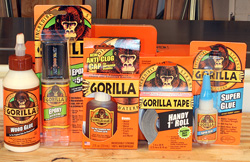 |
Gorilla Glue now covers nearly all types of adhesives used in woodworking. Click image to enlarge |
Gorilla® Glue Expands – Its Line
More adhesive solutions from a pioneer in polyurethane glues
Text, photos and video by Tom Hintz
Posted – 2-8-2012
Years ago I came across Gorilla® Glue. I bought some, used it in my shop and then did a review on it. I liked Gorilla® Glue a lot back then and so did many of you. Naturally there were naysayers as with any of the hundreds of reviews I have done. But if email is an indication the woodworkers who like Gorilla® Glue outweigh those who do not in a big way. It helps to understand the facts about a glue before buying into the low-level hysteria spouted on some forums.
This time the folks at Gorilla® Glue sent me a “media kit” that contained samples of their newly expanded line of adhesives along with the expected promotional materials. I actually did read the printed materials but then took the samples of Gorilla® Glue products to the shop.
Gorilla® Glue Original
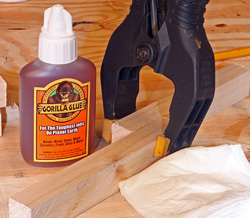 |
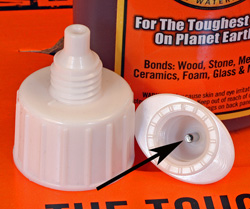 |
The original Gorilla Glue (left) is just as good as it always has been. the big difference is the new cap (right) that uses a stainless steel pin to create a tight seal to preserve the glue longer. Click images to enlarge |
|
Not much has changed about the Gorilla® Glue that made these folks famous. It is still a very tough polyurethane glue that works wonders in lots of situations but in particular outdoors. Heat, moisture and cold don’t stand a chance against Gorilla® Glue, something I have proven over and over again. While riding around the yard on my mower I check the Gorilla® Glue joints that continue to withstand what Mother Nature has thrown at them over the years.
The naysayers say that Gorilla® Glue expands, which it does, three to four times in fact according to the labels on all of the Gorilla® Glue bottles and in all of their printed materials. They warn that a little goes a long way but some use too much and then blame the glue for expanding. Naysayers also say that the foam produced by excess Gorilla® Glue has no strength, again right and again right off of the Gorilla® Glue literature. Excess foam is a direct result of the user applying too much, something another adhesive manufacturer told me happens with about 70% of woodworkers. Most of us use too much glue and that weakens rather than strengthens the joints.
I have also heard many people complain about removing the foam that can occur along the glue line, if you use too much. (Remember that?) In any case, I let the glue and the foam dry and then knock it off with a paint scraper. That works great and any remaining foam sands away easily. I know it’s not dramatic but it works very well. The reality is that used as directed Gorilla® Glue works great.
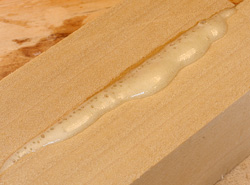 |
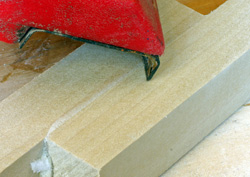 |
If you use too much Gorilla Glue, it will foam (left) out of the seam. If you let it dry and then just scrape it off (right) with a common pain scraper none of the disasters naysayers tout in capital letters and all of the superlatives they can dream up will happen. Click images to enlarge |
|
I have actually had people complain that you have to clamp the pieces being joined with Gorilla® Glue. Again this is true - just as true with every adhesive on the market this side of rubber bands. This kind of complaint makes me think that the naysayers are running out of hype that even they can believe.
Shelf Life
A common knock against Gorilla® Glue was that it has a short shelf life. Here again our excesses were catching up with us. All polyurethane glues cure in the presence of air and the moisture in the air. Since we don’t use up a large bottle of glue quickly some portion of the remaining glue could set up in the bottle. Gorilla® Glue purposely offered smaller bottles. I found that if you squeezed most of the air out of the bottle before closing and then store the bottle upside down, the shelf life went up a bunch, well into months and months. But the folks at Gorilla® Glue came up with an even better idea.
Now Gorilla® Glue comes with a specially designed cap that uses a stainless steel pin to produce a positively air tight seal. (They tested this cap in vacuum chambers!) At this writing I have had a bottle of Gorilla® Glue with the new cap on my bench almost a month since I opened it and squeezed some out. You can see in the video that the new cap design with its pin does the job. You still need to buy a reasonably sized bottle of glue for your use but the cap makes it live much longer than before.
Gorilla® Wood Glue
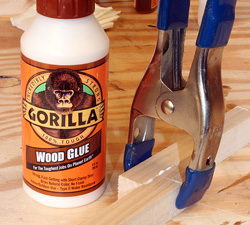 |
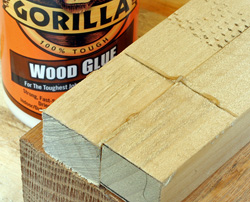 |
Gorilla Wood Glue (left) is easy to use, non-toxic and dries quickly. In the joint failure test (right) wood has been pulled out of both sides of the joint meaning the wood failed, not the glue. as it is supposed to. Click images to enlarge |
|
Designed primarily for wood-to-wood bond applications the Gorilla® Wood Glue is a cross-linked PVA (polyvinyl acetate) formula that is good for indoor and outdoor use. It is rated as a Type II PVA which means it is water resistant (ANSI/HPVA type II) when fully cured. Until then Gorilla® Wood Glue can be cleaned up with plain water. Gorilla® Wood Glue can even be dried using (industrial) radio frequency equipment.
Gorilla® Wood Glue has a 5 to 10-minute open time and a relatively short clamp time of 20 to 30-minutes minutes which can help move a project along. Gorilla® Wood Glue also cures to 80% of its final strength in 1 to 2 hours. When it dries fully it retains its natural tan coloring that blends well with a bunch of wood types. Gorilla® Wood Glue meets FDA (Food and Drug Administration) standards for non-direct food contact plus it is non-toxic and creates no harmful fumes.
Make a tight-fitting joint and use the proper amount of Gorilla® Wood Glue and the glue line is all but invisible. It is also sandable, paintable and mildew-resistant. The bottle Gorilla® Wood Glue comes in has the familiar pull-type spout that is fast and easy to use in the shop. Gorilla® Wood Glue is Made in America.
Gorilla® Super Glue
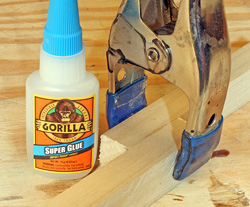 |
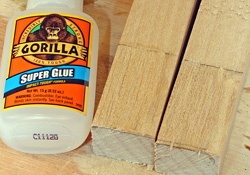 |
The Gorilla Super Glue (left) surprised me most. In our failure test the joint (right) shows wood failure all of the way across the joint. I have done this test with lots of CA-type glues and have never seen this kind of consistency in the joint. this glue either likes poplar a bunch of is just really good Super Glue! Click images to enlarge |
|
Just when you thought all CA (cyanoacrylate) glues were the same, along comes Gorilla® Super Glue things have changed. This is a reasonably thick glue as compared to how others are often rated but it is what you can’t readily see that makes it different. Within the fluid are tiny rubber particles that give dried Gorilla® Super Glue impact resistance you just don’t find in similar glues.
Gorilla® Super Glue has virtually no “working time” as the tack or grab is virtually instant and it dries in 30 to 60 seconds. This glue is translucent in color and sandable when dry. The project can be handled (carefully) in just a few minutes but to insure that the full joint is cured setting it down for 24 hours is the best idea.
One of the most frustrating things with CA type glues over the years has been the spout clogging up. The Gorilla® Super Glue comes in a container featuring a specially designed nozzle that is kept open and ready to use with a steel pin built into the cap. If you have ever stabbed yourself with a pin while trying to poke open a clogged CA bottle, you will love this development. And Gorilla® Super Glue is Made in America.
Gorilla Impact-Tough® Epoxy
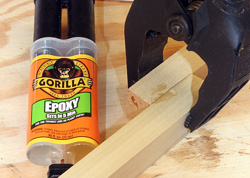 |
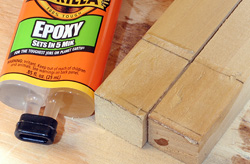 |
The Gorilla Epoxy (left) is mixed and applied as you would any epoxy but seems to work very well and quicker than I anticipated. In the joint failure test (right) the entire joint shows wood separation, a good indicator that the wood is weaker than the epoxy joint. Click images to enlarge |
|
Gorilla Impact-Tough® Epoxy is a two-part adhesive that is considered to be a “fast” epoxy because of the 5-minute working time. What isn’t so run-of-the-mill is its gap-filling capability and solvent resistance. Both make Gorilla Impact-Tough® Epoxy usable in a wide range of projects in the home or professional shop. It dries to a light tan color which blends with many woods and is paintable. You can use Gorilla Impact-Tough® Epoxy on most materials with the exceptions of rubber and paper.
I get a lot of questions from woodworkers looking for ways to “strengthen” a joint they made that has some gaps. It is certainly is not a miracle-worker but Gorilla Impact-Tough® Epoxy can fill small gaps in joints and just might save your day and project.
Gorilla Impact-Tough® Epoxy comes in a familiar syringe-type dispenser that produces equal amounts of the resin and hardener. Mix the two parts well and apply to the joint surfaces. As with all adhesives, clamp the pieces in place until dry to insure proper alignment and bond. Gorilla Impact-Tough® Epoxy is non-toxic once cured. Gorilla Impact-Tough® Epoxy is Made in America.
Gorilla® Tape
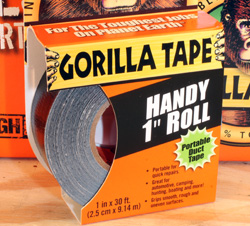 |
Gorilla tape may look like duct tape but it is far stronger in terms of the adhesive grip and the strength of the tape itself. Click image to enlarge |
I have to admit that when I first heard that the folks at Gorilla were making what appeared to be duct tape I thought that there might be a few bubbles in their think tank. Apparently the business of making sticky stuff carries over to tape because they came up with Gorilla® Tape that is better than any duct tape I have used – and I have used a bunch of it. I was in the racing business for like 40 years and that just cannot happen without a bunch of duct tape, or what some called 200 MPH tape. If what we used then was 200 MPH tape, Gorilla® Tape must be good for 500 or 600 MPH. This stuff is an entirely different animal.
The adhesive used on Gorilla® Tape is itself far stronger than any duct tape I have used. The tape backing is also made much differently. They use a reinforced backing that virtually eliminates stretch and that makes the tape stronger as well. The outer coating or shell is waterproof which means that Gorilla® Tape stays where you put it in more applications.
While testing Gorilla® Tape I found that I could wrap it around odd-shaped parts to secure them where clamping was impossible. If you need to tape something to hold it in place, Gorilla® Tape will do the job if any tape can. Now Gorilla® Tape is available in 1” widths that can be very handy around the shop and home.
In the Shop
Testing woodworking glues in a way that would be meaningful to all of my viewers is impossible. We all use glue in so many ways in widely diverse types of projects that common ground is very difficult to find. I decided to do simple break tests of the current group of Gorilla® Glue offerings and let it go at that.
For this group of tests I cut 6”-long pieces of poplar that are roughly 1”-square. Adhesive would be applied to a 1” section at the ends of each piece according to label directions. Each of these samples was clamped using spring clamps and left over night to dry. I could have done this test faster but the air temperature in my shop during this test was about 55-degrees so I opted for longer rather than shorter dry times just to be sure.
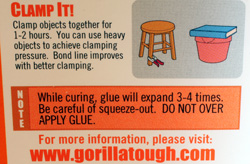 |
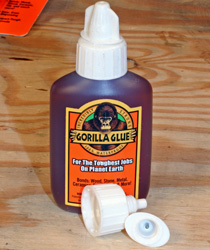 |
All of the Gorilla Glue containers (left) and literature warn about the expansion but this seems to be a hard concept for a lot of people to grasp. We just normally use too much glue but Gorilla Glue shows you how much too much! The new cap and small bottles (right) should make Gorilla Glue friendlier to more woodworkers. C;lick images to enlarge |
|
One of the first things that I discovered was that a 6”-long handle just isn’t enough to break the glue and/or wood with any kind of control. I added a pair of 12” adjustable pliers to give me the leverage I needed to apply a consistent pressure to the joints rather than just smack it with a sledge. What we are looking for is wood being pulled from the surfaces indicating that the wood was failing before the glue itself. Most often we will find wood on both halves of the sample because the bond developed by modern glues is very consistent. You get to see these samples being broken in the accompanying video. (I am hoping that I don’t punch myself in the face while breaking these bonds as nearly happened the last time I did this kind of test….)
Nearly all of the tests went pretty much as expected. All of the breaks showed that the wood was failing far more than the glue. There were small areas where the glue appeared to have failed but I suspect most of those lacked sufficient glue in the first place. With such a small contact area it is likely that I either did not spread the glue to all contact areas or did not get an even coat. Regardless, those spots were surprisingly small and I had to be somewhat of a factor in these results.
The Gorilla® Wood Glue and Epoxy both showed a more even wood failure across the joint than I see with many brands. All of the better wood glues make a very strong joint but the Gorilla® versions seemed to be more uniform across the joint. Maybe that comes from all of the wood samples being cut from the same board or perhaps it is just a consistency in the bond created by these glues.
The Gorilla® Super Glue surprised me most with wood transfer across the entire joint. Usually the CA glues set up too fast to spread across the joint under pressure and it always seems difficult to get an even coat across the entire joint. I actually went back and repeated the test with the Gorilla® Super Glue but this time only let the glue cure for about five hours. The results were the same when the joint was pressured to failure. The wood transfer was very even across the entire joint and looked the same in both tests.
Conclusions
Video Tour |
The folks at Gorilla® Glue appear to take the design and creation of woodworking adhesives seriously. The range of products shown here covers the majority of woodworkers needs very well. These adhesives are easy to use, tough and have the properties we like such as strong holding power and sandability.
I usually quote street prices in reviews but all of the Gorilla® Glues are priced very close to comparable glues on the market. Everywhere I looked the difference in pricing between Gorilla® Glue products and the competitors was too small to be a purchasing consideration. I look more to the strength and ease of use when buying my adhesives. The new Gorilla® Glues as well as their original polyurethane adhesives remain at the top of my list. Buy bottle sizes that realistically fit your needs, remember to close the new hyper-effective new caps and your Gorilla® Glues will be ready to use when you need them.
Visit the Gorilla® Glue web site – Click Here
Have a comment on this review? –Email Me!
All written, photographic and drawn materials are property of and copyright by NewWoodworker.com LLC 2000-2019. Materials may not be used in any way without the written permission of the owner.
